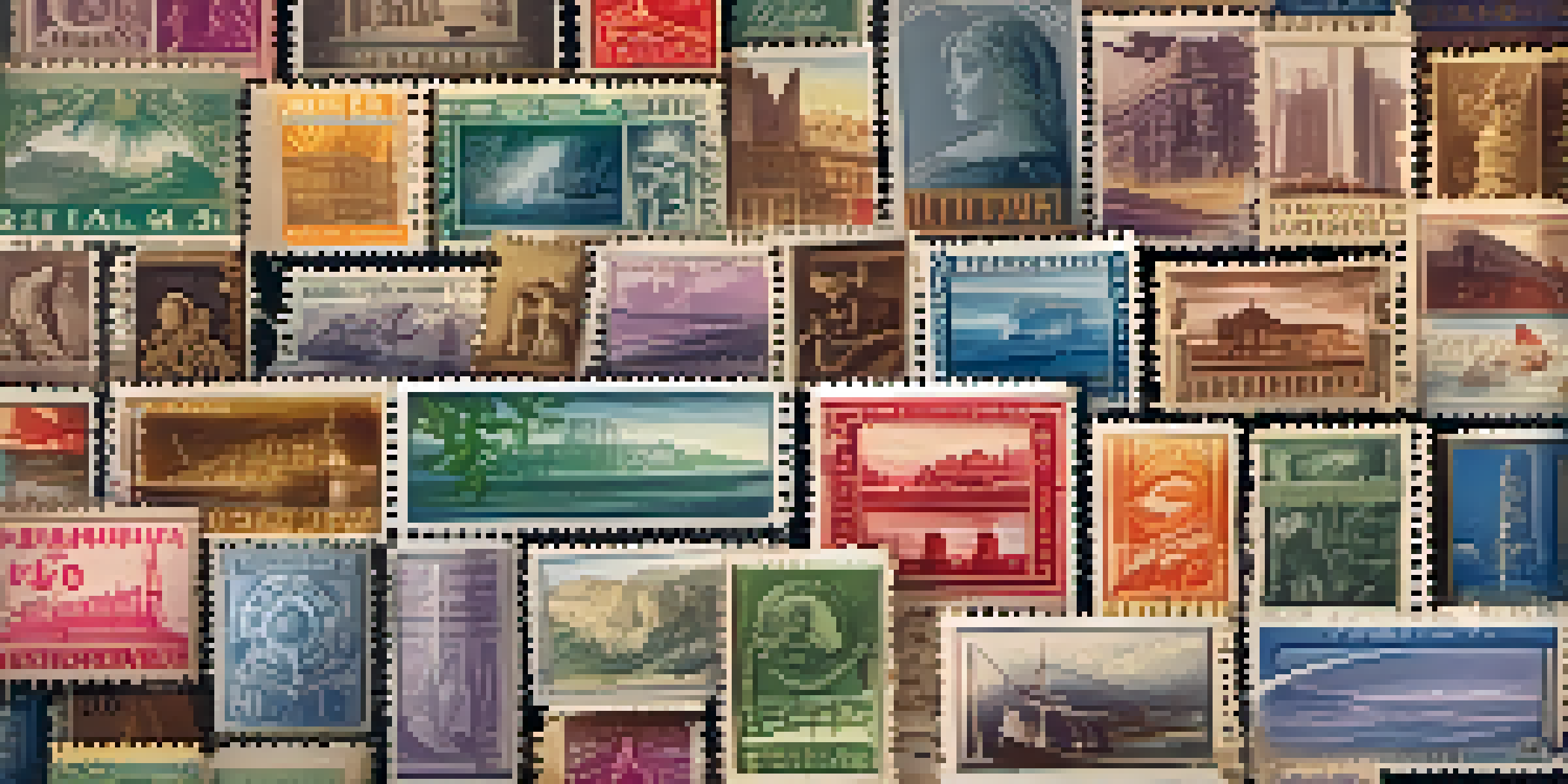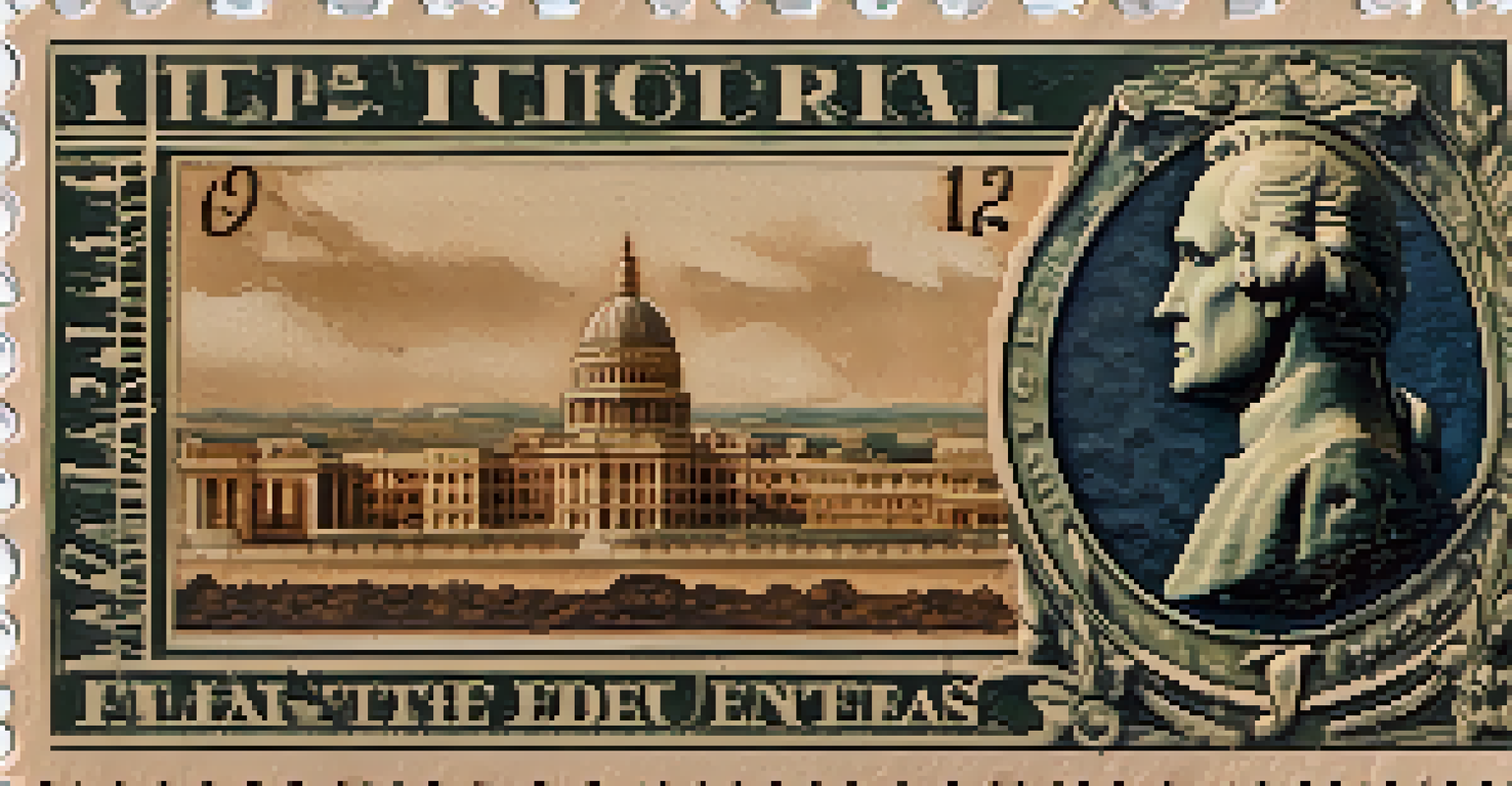The Role of Stamps in Historical Events and Movements

Stamps: More Than Just Postal Tools
Stamps are often seen as simple postage tools, but their role in history is profound. They have served as miniature pieces of art and communication, reflecting the values and events of their time. From their inception in the 19th century, stamps have provided insights into the political and social climates of various eras.
Stamps are the ambassadors of the world, bridging cultures and histories through small pieces of paper.
For example, the Penny Black, the world's first adhesive postage stamp, revolutionized mail delivery and made communication accessible to the masses. It marked the beginning of a new era in postal history, symbolizing progress and connectivity. As such, stamps became a canvas for expressing national identity and pride.
In essence, stamps encapsulate stories of their time, serving as historical artifacts that can spark curiosity and conversation. Each stamp carries the weight of its era, inviting us to delve deeper into the narratives they depict.
Stamps as Propaganda Tools
Throughout history, stamps have been used as powerful propaganda tools during wars and political movements. They have conveyed messages of nationalism, unity, and patriotism, rallying citizens around a common cause. For instance, during World War II, many countries issued stamps that promoted war bonds or celebrated military victories.

These stamps often featured iconic imagery, such as national flags or military heroes, designed to evoke pride and encourage support for the war effort. By embedding political messages into everyday objects, governments could reach a broad audience and influence public sentiment effectively.
Stamps as Historical Artifacts
Stamps serve as miniature art pieces that reflect the social and political climates of their time, encapsulating stories and narratives.
The use of stamps in this way highlights their ability to transcend mere functionality, transforming them into instruments of change and mobilization. This aspect of stamps demonstrates how even small items can play significant roles in shaping the course of history.
Stamps and Social Movements
Beyond wars, stamps have also supported social movements, becoming symbols of hope and change. They have been used to raise awareness for various causes, such as civil rights, environmentalism, and humanitarian efforts. For example, the United States Postal Service issued stamps celebrating Martin Luther King Jr. and the Civil Rights Movement, highlighting the importance of equality and justice.
The art of communication is the language of leadership, and stamps play a crucial role in that narrative.
These stamps serve not only as reminders of past struggles but also as encouragement for ongoing efforts toward social change. By commemorating significant figures and events, stamps can inspire new generations to advocate for rights and reforms.
In this way, stamps transform into powerful artifacts of social consciousness, reminding us of the collective journeys toward justice and equality. They capture the essence of movements, making history accessible and relatable to everyone.
Cultural Reflections in Stamp Design
Stamp designs often reflect the culture and heritage of a nation, showcasing its artistic and historical richness. From traditional motifs to contemporary art, stamps can tell stories about a country’s identity and values. For instance, many countries honor their indigenous cultures through stamps, offering a visual celebration of diversity.
Additionally, stamps can highlight significant cultural events, such as festivals or anniversaries, fostering a sense of community and national pride. By showcasing these elements, stamps promote cultural heritage and encourage appreciation for a nation’s history.
Stamps in Social Movements
Stamps have been used to raise awareness for social movements, becoming powerful symbols of hope and change.
As a result, stamps serve as cultural ambassadors, connecting people across borders and generations. They remind us of our shared humanity and the importance of celebrating and preserving our unique traditions.
The Role of Stamps in International Relations
Stamps also play a subtle yet significant role in international relations. They can symbolize diplomatic ties and mutual respect between nations. For example, countries often issue stamps commemorating significant diplomatic milestones, such as treaties or peace agreements, showcasing their commitment to cooperation.
Moreover, stamp exchanges between nations foster goodwill and cultural exchange. Philately, or stamp collecting, encourages enthusiasts to learn about different cultures and histories, creating connections that transcend borders.
Through these interactions, stamps contribute to a broader understanding of global interconnectedness. They remind us that, despite our differences, we share common goals of peace and collaboration.
Collecting Stamps: A Window to History
Stamp collecting, or philately, offers a unique lens through which to explore history. Collectors often seek out specific stamps that reflect personal interests or historical significance, creating a tangible connection to the past. Each stamp in a collection carries its own story, waiting to be uncovered and appreciated.
For many collectors, the thrill lies not just in ownership but in the journey of discovery. Researching the origins, significance, and rarity of stamps can lead to fascinating insights into historical events and cultural shifts. It transforms collecting into a lifelong learning experience.
Future of Stamps in Digital Era
Despite the rise of digital communication, stamps remain valuable as collectibles and cultural symbols, hinting at a potential renaissance in their use.
This passion for philately fosters a sense of community among collectors, as they share knowledge and swap stories. Ultimately, stamp collecting serves as a bridge to history, enabling individuals to engage with the past in a meaningful way.
Future of Stamps in a Digital Age
In an increasingly digital world, the future of stamps is an intriguing topic. While email and instant messaging have changed how we communicate, stamps continue to hold value as collectibles and cultural symbols. Many postal services are adapting by introducing digital stamps that allow for online use while preserving the essence of traditional stamps.
Moreover, as nostalgia for physical mail persists, stamps may experience a renaissance among younger generations who appreciate their artistic and historical significance. This could lead to renewed interest in both collecting and sending letters with stamps.

As we navigate this digital landscape, stamps remind us of the importance of tangible connections and the stories they carry. They may evolve, but their role as historical artifacts will endure, continuing to inspire curiosity and appreciation for the past.